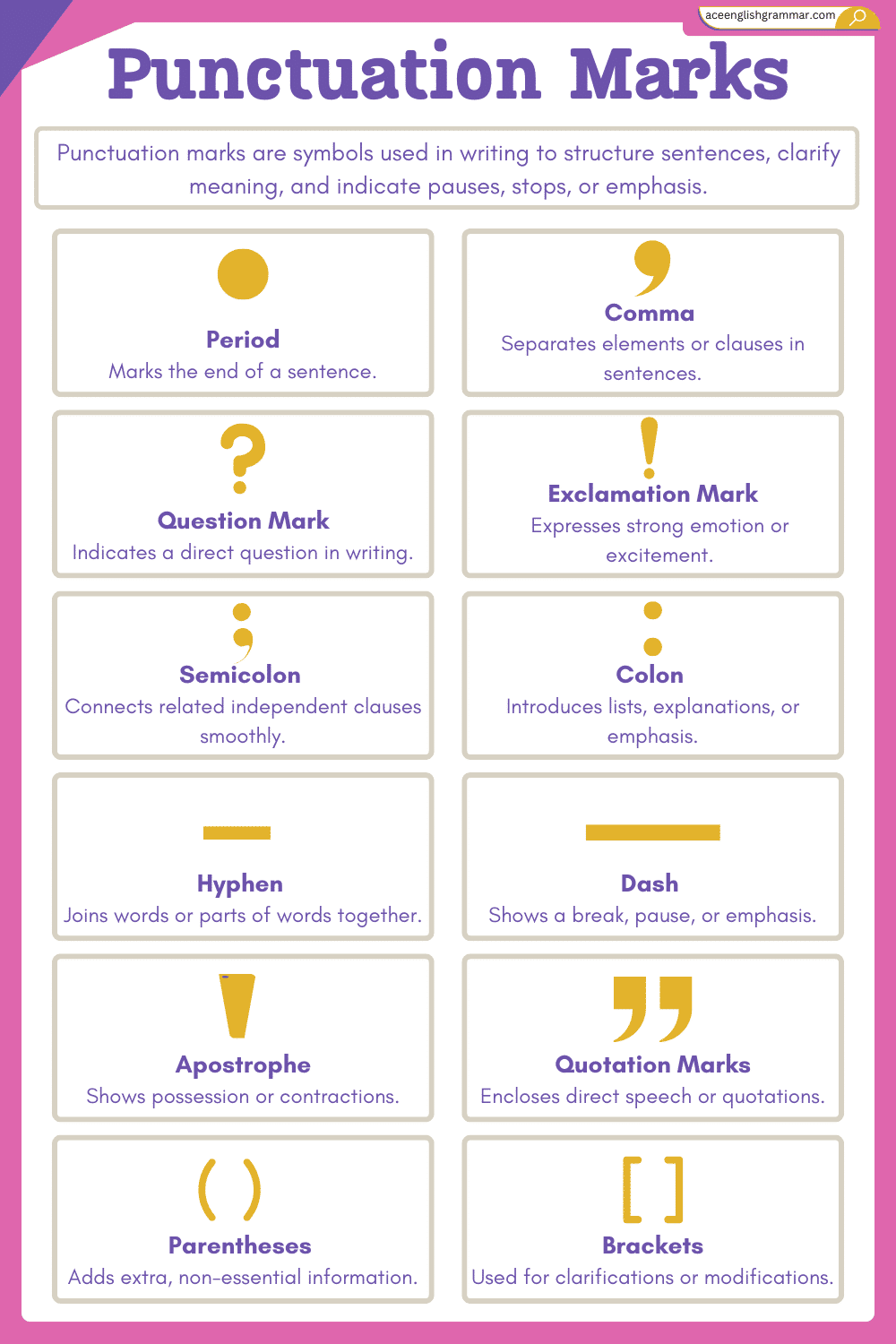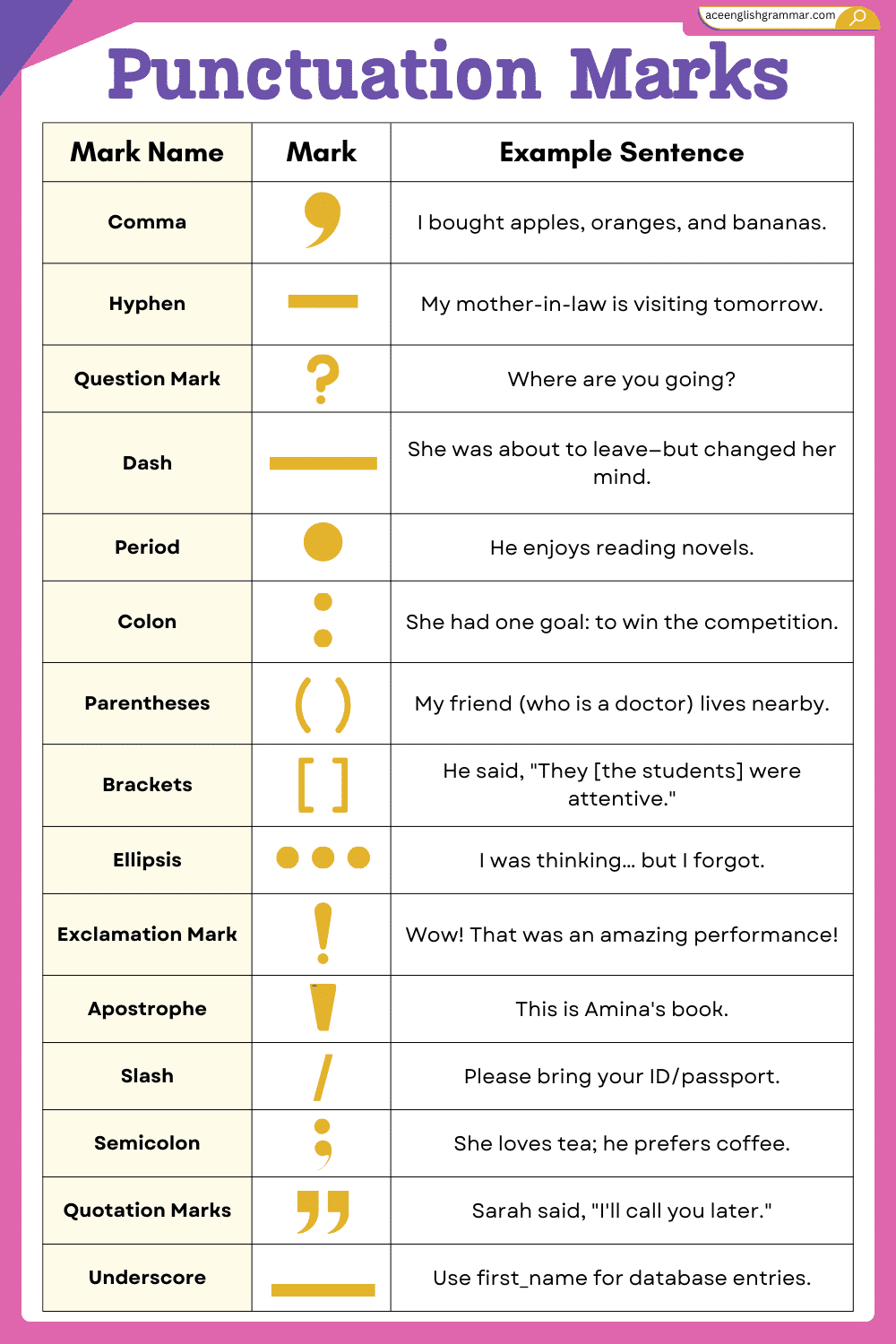Try reading a sentence with no commas, no periods — just words running endlessly. It’s messy, right? Hard to follow, maybe even a little annoying. That’s exactly why punctuation matters. It gives your writing structure, helps your ideas land clearly, and keeps things readable. Without it, even the simplest sentence can get misunderstood. If you want to write well, you’ve got to get the hang of punctuation. It’s that simple.
Table of Contents
Definition of Punctuation
Punctuation marks are symbols used in writing to separate sentences, clarify meaning, and indicate pauses or emphasis. They help convey the intended tone and structure of a sentence, making communication more effective.

Importance of Punctuation in Writing
- Enhances clarity – Proper punctuation ensures that the message is easily understood.
- Prevents ambiguity – It helps avoid misinterpretation of sentences.
- Improves readability – Well-punctuated text is easier to follow and comprehend.
- Conveys tone – Punctuation marks help express emotions and emphasis in writing.
Types of Punctuation Marks
Here is a list of 14 punctuation marks used in writing for better understanding. These marks help structure sentences, clarify meaning, and improve readability.
- Period (.)
- Comma (,)
- Question Mark (?)
- Exclamation Mark (!)
- Semicolon (;)
- Colon (:)
- Hyphen (-)
- Dash (—)
- Apostrophe (‘)
- Quotation Marks (” “)
- Parentheses ( )
- Brackets [ ]
- Ellipsis (…)
- Slash (/)
Ending Punctuation
- Period (.)
It marks the end of a declarative or imperative sentence, showing completion.- Fatima loves reading novels.
- Question Mark (?)
Used at the end of a sentence to indicate a direct question.- Where is Ahmed going?
- Exclamation Mark (!)
Expresses strong emotions like excitement, surprise, or anger.- That was an amazing performance!
Commas and Pauses
- Comma (,)
Separates words, phrases, or clauses for better readability.- Ali bought apples, oranges, and bananas.
- Semicolon (;)
Links closely related independent clauses without a conjunction.- Mariam loves coffee; she drinks it every morning.
- Colon (:)
Introduces lists, explanations, or emphasizes the next part of a sentence.- He had one dream: to travel the world.
Quotation and Emphasis Marks
- Quotation Marks (” “)
Used to enclose direct speech, quotes, or specific phrases.- Ayesha said, “I will complete my assignment today.”
- Apostrophe (‘)
Shows possession (ownership) or contractions (shortened words).- This is Bilal’s book.
Brackets and Parentheses
- Parentheses ( () )
Adds non-essential information without breaking sentence flow.- My sister (who is a doctor) lives in London.
- Brackets [ ]
Used for clarifications, modifications, or additional explanations.- He said, “They [the students] were very attentive.”
Dashes and Hyphens
- Hyphen (-)
Connects compound words or separates syllables in some cases.- My mother-in-law is visiting today.
- Dash (—)
Creates emphasis, indicates interruptions, or replaces commas.- She was about to speak—but changed her mind.
Other Special Punctuation Marks
- Ellipsis (…)
Shows omitted words, pauses, or unfinished thoughts.- I don’t know… maybe we should wait.
- Slash (/)
Represents alternatives, fractions, or abbreviations.- Please bring your ID/passport for verification.

Hyphen (-) vs. Dash (—)
| Punctuation | Definition | Example |
|---|---|---|
| Hyphen (-) | Joins words to form a compound. | My father-in-law is visiting. |
| Dash (—) | Indicates a pause or break in a sentence. | I wanted to call her—but I forgot. |
Comma (,) vs. Semicolon (;)
| Punctuation | Definition | Example |
|---|---|---|
| Comma (,) | Separates items in a list or different parts of a sentence. | We bought apples, oranges, and bananas. |
| Semicolon (;) | Connects two related independent clauses without a conjunction. | I was tired; I still finished my work. |
Colon (:) vs. Semicolon (;)
| Punctuation | Definition | Example |
|---|---|---|
| Colon (:) | Introduces a list, explanation, or emphasis. | There is one rule: always be honest. |
| Semicolon (;) | Links independent clauses without a conjunction. | It was raining; we stayed inside. |
Brackets [ ] vs. Parentheses ( )
| Punctuation | Definition | Example |
|---|---|---|
| Brackets [ ] | Clarify or add information in a quote. | He said, “They [the students] worked hard.” |
| Parentheses ( ) | Insert extra, non-essential details in a sentence. | My friend (a teacher) lives in London. |
Rules and Usage of Punctuation Marks
- Use a period at the end of declarative sentences.
- Place commas appropriately to avoid run-on sentences.
- Use quotation marks for direct speech or citations.
- Colons introduce lists or further explanations.
- Semicolons separate independent clauses when no conjunction is used.
Common Punctuation Mistakes and How to Avoid Them
- Overuse of commas – Avoid placing commas unnecessarily.
❌ She went to the market, and bought apples.
✅ She went to the market and bought apples. - Incorrect apostrophe use – Do not use apostrophes for plurals.
❌ The cat’s are playing.
✅ The cats are playing. - Misuse of semicolons – Semicolons should connect two related independent clauses.
❌ I love coffee; because it wakes me up.
✅ I love coffee; it wakes me up.
FAQs
The 14 punctuation marks include the period, question mark, exclamation mark, comma, semicolon, colon, quotation marks, apostrophe, parentheses, brackets, hyphen, dash, ellipsis, and slash.
Punctuation helps clarify meaning, improve readability, and prevent misunderstandings. It structures writing and conveys emotions effectively.
A semicolon connects two independent clauses without a conjunction. Example: “I love to write; it helps me express my thoughts.”
Use parentheses to add extra information that is not essential to the main sentence. Example: “Sarah (my cousin) will visit next week.”
A hyphen (-) connects compound words, while a dash (—) indicates a pause or break in thought.
Brackets clarify or add information in a quote and Parentheses Insert extra, non-essential details in a sentence.
Conclusion
If you want your writing to actually make sense, punctuation isn’t optional — it’s everything. Every mark you use, from a tiny comma to a full stop, helps shape your message and make it easier to follow. Get the hang of how they work, and you’ll avoid a lot of silly mistakes. It might take a bit of practice, but soon enough, using punctuation the right way will just feel natural.
Download PDF
This PDF provides a complete guide to the 14 essential punctuation marks, their definitions, uses, and examples to help learners improve their writing skills. Download now for quick reference!
Read More
